Recovering Mailboxes
Follow the steps given below to browse an archive set and recover a mailbox:
-
From the CommCell Browser, expand Client Computers > client > Domino Mailbox Archiver > instance.
-
Right click the archive set that contains the data you want to restore, and then click All Tasks | Browse and Restore.
-
Click View Content.
-
In the Client Browse tab, select the data to be recovered and click Recover all Selected.
The Restore Options for All Selected Items dialog box is displayed.
-
In the Destination Client list, select the name of a client computer where you want to restore your mailboxes.
-
Clear the Recover to Same Paths check box.
-
Click OK.
Note
By default, Design Documents are not archived, and therefore, not recovered even when selected.
Recovering Messages
Follow the steps given below to browse a backup set and recover a message or a mailbox item, such as a folder, a contact, a calendar entry:
-
From the CommCell Browser, expand Client Computers > client > Domino Mailbox Archiver > instance.
-
Right click the archive set that contains the data you want to restore, and then click All Tasks | Browse and Restore.
-
Click View Content.
-
In the Client Browse tab, select the data to be recovered and click Recover all Selected.
The Restore Options for All Selected Items dialog box is displayed.
-
Navigate to defaultArchiveSet | <Mailbox> | <Folder> in the left pane of the Client Browse window.
-
Select a message or a mailbox item from the right pane.
-
Click Recover All Selected.
-
Click OK.

Performing an In-Place Recovery
Follow the steps given below to restore data to perform an in-place recovery:
-
From the CommCell Browser, expand Client Computers > client > Domino Mailbox Archiver > instance.
-
Right click the archive set that contains the data you want to restore, and then click All Tasks | Browse and Restore.
-
Click View Content.
-
In the Client Browse tab, select the data to be recovered and click Recover all Selected.
The Restore Options for All Selected Items dialog box is displayed.
-
Click OK.
Performing an Out-of-Place Recovery
Recovering to a Different Folder on the Same Client
Follow the steps given below to restore data to a different folder on the same client from which data is backed up:
Before You Begin
-
At the destination location, create a new folder to restore the mailbox in this folder.
-
In this new folder, create a new mailbox with the same name as the mailbox that you want to restore.
Procedure
-
From the CommCell Browser, expand Client Computers > client > Domino Mailbox Archiver > instance.
-
Right click the archive set that contains the data you want to restore, and then click All Tasks > Browse and Restore.
-
Click View Content.
-
In the Client Browse tab, select the data to be recovered and click Recover all Selected.
The Restore Options for All Selected Items dialog box is displayed.
-
Clear the Recover to Same Paths check box.
-
In the Specify Destination Path, type the absolute path of the destination location.
For example, if the name of the new folder that you created at the destination location is "folder1", then type the absolute path till folder1.
-
Click OK.
Recovering to a Different Client
Follow the steps given below to browse an archive set and recover to a different client computer.
Before You Begin
-
At the destination location, create a new folder to restore the mailbox in this folder.
-
In this new folder, create a new mailbox with the same name as the mailbox that you want to restore.
Procedure
-
From the CommCell Browser, expand Client Computers > client > Domino Mailbox Archiver > instance.
-
Right click the archive set that contains the data you want to restore, and then click All Tasks > Browse and Restore.
-
Click View Content.
-
In the Client Browse tab, select the data to be recovered and click Recover all Selected.
The Restore Options for All Selected Items dialog box is displayed.
-
In the Destination Client list, select the name of client computer where you want to restore your mailboxes.
-
Clear the Recover to Same paths check box.
-
In the Specify Destination Path, type the absolute path of the destination location.
For example, if the name of the new folder that you created at the destination location is "folder1", then type the absolute path till folder1.
-
Click OK.
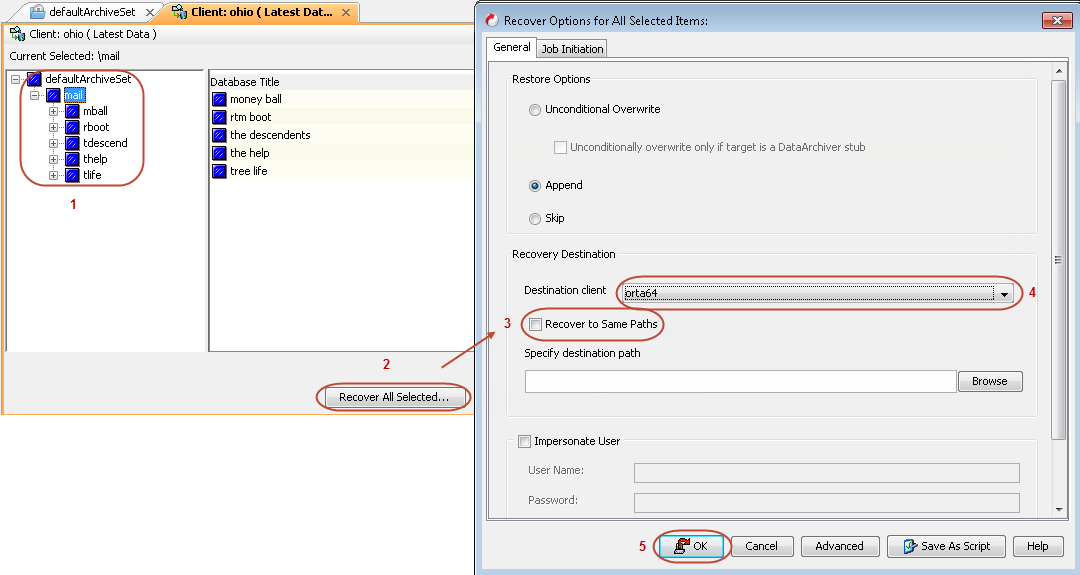
Recovering to Network Path
Follow the steps below to restore data to a different folder in any network path (supported on Windows):
-
From the CommCell Browser, expand Client Computers > client > Domino Mailbox Archiver > instance.
-
Right click the archive set that contains the data you want to restore, and then click All Tasks | Browse and Restore.
-
Click View Content.
-
In the Client Browse tab, select the data to be recovered and click Recover all Selected.
The Restore Options for All Selected Items dialog box is displayed.
-
Clear the Recover to Same Paths check box.
-
In the Specify Destination Path, type the network path.
-
Check the Impersonate User check box.
-
Type the credentials for the remote location.
-
Click OK.
Performing Point-in-Time Restore Operations across Backup Cycles and Subclients
You can browse and recover data spanning multiple subclients. Browsing and recovering data across subclients within a backup set recovers messages across multiple backup cycles for one or more subclients.
Follow the steps given below to browse and restore data spanning multiple subclients:
-
Install the MediaAgent on the CommServe computer.
-
From the CommCell Browser, expand Client Computers > client > Domino Mailbox Archiver > instance.
-
Right click the archive set that contains the data you want to restore, and then click All Tasks | Browse and Restore.
-
Select Time Range and select Absolute Time.
-
Select the Time Zone, enter the Start Date and time and the End Data and time.
-
Click View Content.
-
Select the folder level under the backup set. Its entire contents will be automatically selected in the right pane.
-
Click Recover All Selected.
The Restore Options for All Selected Items dialog box is displayed.
-
From the General tab, you can either perform an in-place recovery by selecting the Recover to Same Paths check box or perform an out-of-place recovery by specifying a location in the Specify destination path box.
-
Click the Job Initiation tab.
-
Select Immediate to run the job immediately.
-
Click OK.
You can monitor the progress of the restore job in the Job Controller of the CommCell Console.
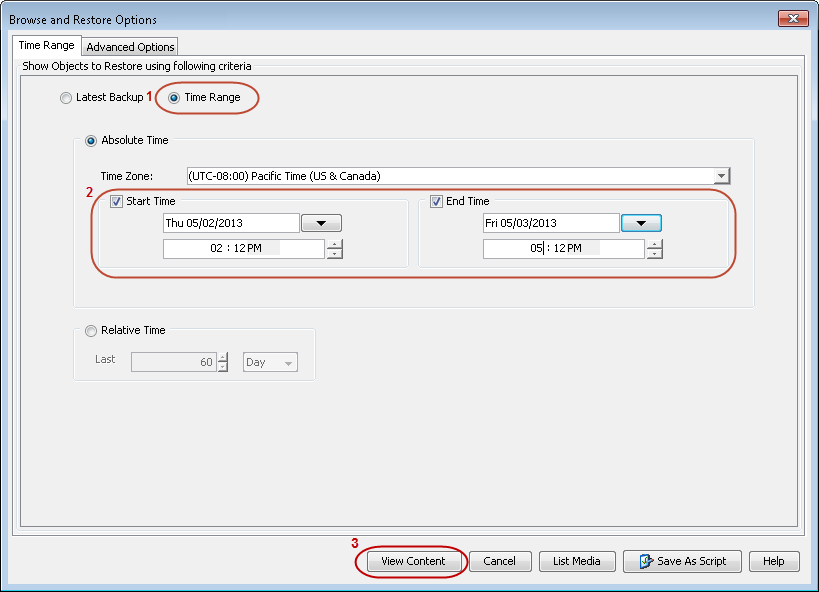
Scheduling Message Recovery
-
From the CommCell Browser, expand Client Computers > client > Domino Mailbox Archiver > instance.
-
Right click the archive set that contains the data you want to restore, and then click All Tasks | Browse and Restore.
-
Click View Content.
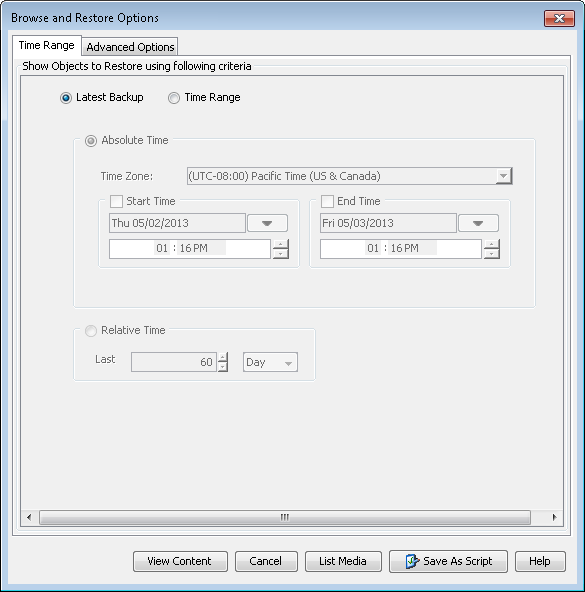
-
Select one or more mailboxes in the left pane. The mailbox items (e.g., calendars, journals, etc.) will be selected in the right pane.
Click Recover All Selected.
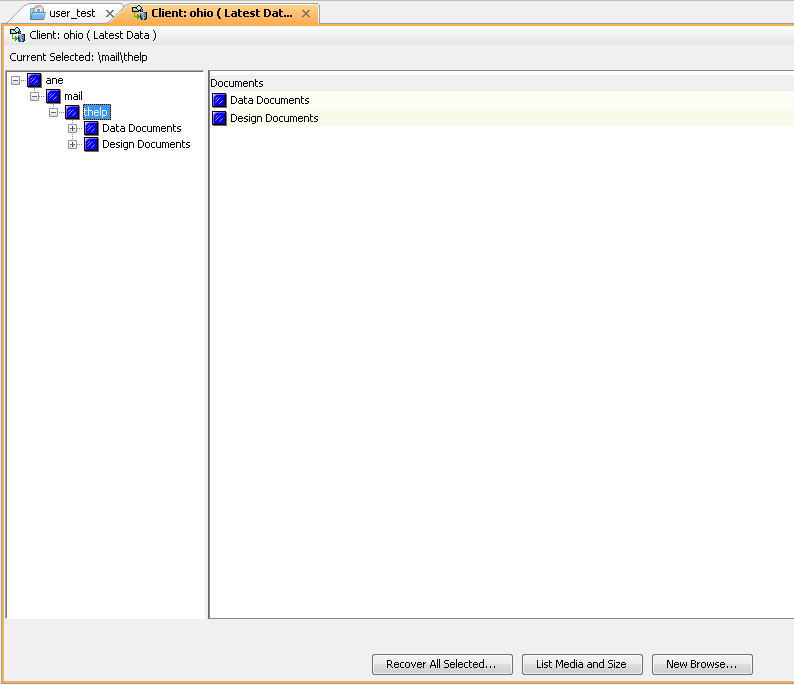
-
Click Job Initiation tab and click Schedule.
Click Configure.

-
Select the appropriate scheduling options. For example:
Click Weekly.
Check the days you want the run the restore job.
Change the Start Time to 9:00 PM
Click OK to close the Schedule Details dialog
Click OK to close the Restore Options dialog
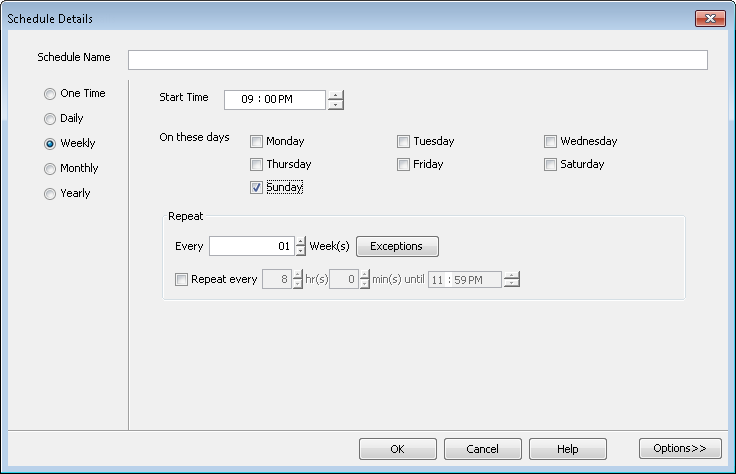
Managing Recovery Jobs
Once you initiate the restore operation, a restore job is generated in the Job Controller. Jobs can be managed in a number of ways. The following sections provide information on the different job management options available:
Restarting Jobs
Jobs that fail to complete successfully are automatically restarted based on the job restartability configuration set in the Control Panel.
Changes made to this configuration will affect all jobs in the entire CommCell.
To configure the job restartability for a specific job, you can modify the retry settings for that job. This will override the setting in the Control Panel. It is also possible to override the default CommServe configuration for individual jobs by configuring retry settings when initiating the job. This configuration, however, will apply only to the specific job.
Note
Backup jobs for this Agent are resumed from the point-of-failure.
Configure Job Restartability at the CommServe Level
-
From the CommCell Console ribbon, click the Home tab, and then click Control Panel.
-
Under Data, click Job Management.
The Job Management dialog box appears.
-
Click the Job Restarts tab.
-
From the Job Type list, select the appropriate item.
-
Select the Restartable check box to make the job restartable.
-
In the Max Restarts box, change the maximum number of times the Job Manager will try to restart a job.
-
In the Restart Interval (Mins) box, change the time interval between attempts for the Job Manager to restart the job.
-
Click OK.
Configure Job Restartability for an Individual Job
-
From the CommCell Browser, navigate to Client Computers | <Client> | Domino Mailbox | <Archive Set>.
-
Right click the <Subclient> in the right pane and then click Browse Backup Data.
-
Click OK.
-
Select the data that you want to restore and click Recover All Selected.
-
Click Advanced and select the Job Retry tab
-
Select Enable Total Running Time and specify the maximum elapsed time before a job can be restarted or killed
-
Select Kill Running Jobs When Total Running Time Expires to kill the job after reaching the maximum elapsed time.
-
Select Enable Number Of Retries and specify the number of retries.
-
Click OK.
Controlling Jobs
The following controls are available for running jobs in the Job Controller window:
|
Suspend |
Temporarily stops a job. A suspended job is not terminated; it can be restarted at a later time. |
|
Resume |
Resumes a job and returns the status to Waiting, Pending, Queued, or Running. The status depends on the availability of resources, the state of the Operation Windows, or the Activity Control setting. |
|
Kill |
Terminates a job. |
Suspending a Job
-
From the Job Controller of the CommCell Console, right-click the job and select Suspend.
-
The job status may change to Suspend Pending for a few moments while the operation completes. The job status then changes to Suspended.
Resuming a Job
-
From the Job Controller of the CommCell Console, right-click the job and select Resume.
-
As the Job Manager attempts to restart the job, the job status changes to Waiting, Pending, or Running.
Killing a Job
-
From the Job Controller of the CommCell Console, right-click the job and select Kill.
-
Click Yes when the confirmation prompt appears if you are sure you want to kill the job. The job status may change to Kill Pending for a few moments while the operation completes. Once completed, the job status will change to Killed and it will be removed from the Job Controller window after five minutes.
Additional Restore Options
Several additional options are available to further refine your restore operations. The following table describes these options, as well as the steps to implement them.
Be sure to read the overview material referenced for each feature prior to using them.
|
Option |
Description |
Related Topic |
|
Startup |
The Startup Options are used by the Job Manager to set priority for resource allocation. This is useful to give higher priority to certain jobs. You can set the priority as follows:
|
Refer to Job Priority and Priority Precedence. |
|
Copy Precedence |
By default, the system retrieves data from the storage policy copy with the lowest copy precedence. If the data was pruned from the primary copy, the system automatically retrieves data from the other copies of the storage policy in the lowest copy precedence to highest copy precedence order. Once the data is found, it is retrieved, and no further copies are checked. You can retrieve data from a specific storage policy copy (Synchronous Copy or Selective Copy). If data does not exist in the specified copy, the data retrieve operation fails even if the data exists in another copy of the same storage policy. Follow the steps given below to retrieve the data from a specific storage policy copy:
|
Refer to Recovering Data From Copies. |
|
Data Path Options |
The data recovery operations use a default Library, MediaAgent, Drive Pool, and Drive as the Data Path. You can use this option to change the data path if the default data path is not available. Follow the steps given below to change the default data path:
|
Refer to Change Data Path. |
|
Encryption |
If the client's data is encrypted with a pass phrase, you must enter the pass-phrase to start the data recovery operation. Follow the steps given below to enter the pass-phrase:
|
Refer to Data Encryption. |
|
Browse Options |
Deleted files can be manually restored by the user. You can specify the time range for the deleted items to be restored.
|
Refer to Job Management. |
|
Alert |
This option enables users or user groups to get automatic notification on the status of the data recovery job. Follow the steps given below to set up the criteria to raise notifications/alerts:
|
Refer to Alerts and Notifications. |
|
Command Line Restores |
Command Line Interface enables you to perform backups or restore from the command line. The commands can be executed from the command line or can be integrated into scripts. You can also generate command line scripts for specific operations from the CommCell Browser using the Save As Script option. |
Refer to Command Line. |
|
CommCell Readiness Report |
The CommCell Readiness Report provides you with vital information such as connectivity and readiness of the Client, MediaAgent, and CommServe. It is useful to run this report before performing a backup or a recovery operation. Follow the steps given below to generate the report:
|
Refer to CommCell Readiness Report. |
|
Restore Job Summary Report |
The Restore Job Summary Report provides you with information about all the data recovery jobs that are run in last 24 hours for a specific client and agent. You can get information such as failure reason, failed objects, job options, and so on. It is useful to run this report after performing the restore. Follow the steps given below to generate the report:
|
Refer to Restore Job Summary Report. |